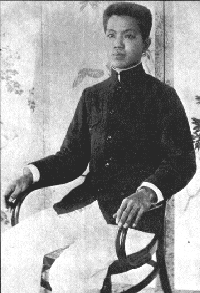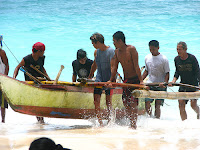The Philippine archipelago lies in Southeast Asia in a position that has led to its becoming a cultural crossroads, a place where Malays, Moro, Chinese, Japanese, Spaniards, Americans, and others have interacted to forge that unique cultural and racial blend known to the world as FILIPINOS.
 |
| Efren Peñaflorida |
The Filipino character is actually a little bit of all the cultures put together. The bayanihan or spirit of kinship and camaraderie that Filipinos are famous for is said to be taken from Malay forefathers.
The close family relations are said to have been inherited from the Chinese. The piousness comes from the Spaniards who introduced Christianity in the 16th century.
 |
| A typical Filipino family |
Filipinos owing to their beautiful country, are passionately romantic. They are ardent in love as they are fierce in battle. They are born poets, musicians and artists. Today, Filipinos are predominantly Roman Catholics, the remaining are Muslims, Buddhists, Hindus and smaller groups are from indigenous tribes.
 |
| Procession of the Black Nazarene at Quiapo, Manila |
 |
| Filipino Muslims bow in prayer at the Rizal Park in Manila |
Filipinos are the third-largest English speakers in the world. A lot of Filipinos are multi-linguals, very good speakers of different languages like Chinese (Fokien, Cantonese, Mandarin, Taiwanese), Japanese (Nihongo), Korean (Hangul), Arabic, Spanish and Indo-Malay-Polynesian, aside from speaking different local dialects like Tagalog (where Filipino language is derived from), Cebuano, Ilocano, Hiligaynon, Waray-Waray, Kapampangan, Bicolano, Pangasinense, Kinaray-a, Maranao, Maguindanao, Tausug, and Chavacano (Zamboanga Spanish).
Filipinos are a fun-loving people, touted as one of the happiest and friendliest citizens in the world. Very well known for their warm and hospitable smiles, the finest in Asia.

Throughout the islands, there are fiestas celebrated everyday with sumptuous food and delicacies; and guests, local or foreign are always welcome to their homes.

Although, the common masses are below poverty line, and usually the country has always been struck by calamities like earthquakes, volcanic eruptions, violent typhoons and floods, it does not stop Filipinos from being optimistic and are always looking forward to a brand new day. Filipinos got the strength of a Narra tree and the resiliency of a Bamboo plant.
Filipinos are a freedom-loving people, having waged two peaceful, bloodless People Power Revolutions against what were perceived as corrupt regimes. The Philippines is a vibrant democracy, as evidenced by 12 English national newspapers, 7 national television stations, hundreds of cable TV stations, and 2,000 radio stations. Men, women, elderly and children have equal rights and are free to participate in any civic, educational, scientific, sports, marginalized and LGBT groups.
























































































